Spatiotemporal Variation of Groundwater Extraction Intensity Based on Geostatistics—Set Pair Analysis in Daxing District of Beijing, China
Abstract
:1. Introduction
2. Materials and Methods
2.1. Study Area
2.2. Data Sources
2.2.1. Groundwater Water Level Data
2.2.2. Statistical Information
2.3. Research Method
2.3.1. Error Calculation Methods for the Interpolation Model
- The mean square error
- Root mean square error
- Nash–Sutcliffe efficiency coefficient
2.3.2. Calculating the Nugget Effect
2.3.3. Evaluation and Diagnosis of Groundwater Exploitation Intensity Based on Set Pair Analysis
- Establishment of an evaluation index system and classification of regional groundwater extraction intensity
- 2.
- Calculation of connection numbers for evaluation samples
- 3.
- Calculation of the connection number of the evaluation index
- 4.
- Calculation of average contact number
- 5.
- Determination of the intensity levels of underground extraction
- 6.
- Diagnosis of groundwater extraction intensity based on the number of linkages
3. Results and Discussion
3.1. Results of the Interpolation Calculation of Water Table Depth
3.2. The Spatial-Temporal Distribution Rules of Water Table Depth
3.3. Spatial Variability Analysis of Groundwater Depth
3.4. Determination of Groundwater Exploitation Intensity Levels and Identification of Key Control Years in the Daxing District Using Set Pair Analysis
3.5. Identification of Main Factors Affecting Groundwater Exploitation Intensity in the Daxing District Based on Subtraction Set Pair Potential
3.6. Research Implications and Limitations
4. Conclusions
- The OK method is selected as the best interpolation model after comparing the prediction accuracies of seven interpolation methods for the water table burial depth in the study area. The OK method had significantly higher accuracy than those of SK and UK. Its ME did not differ much from those of the other methods, but it had a significantly smaller RMSE.
- The spatial interpolation of groundwater table depth in the study area from 1986 to 2016 is conducted using the OK method. The interpolation results showed that the overall groundwater table depth in the Daxing District increased from 1986 to 2016. The rate of groundwater decline was fastest from 1996 to 2006, with an annual decline rate of 0.65 m. The region with the largest decline rate of groundwater table depth in the Daxing District from 1986 to 2016 is the central area, followed by the northern and southern areas. Groundwater downwelling funnels occurred in Qingyundian and Beizangcun in the central region, which tended to continuously spread outward.
- The nugget effect from 1986 to 2016 was calculated using the geostatistical variation function model, which showed that the nugget effect of groundwater table depth increased continuously. The spatial correlation gradually weakened from 1986 to 2016. From 1986 to 2005, the effect of natural structural factors on the burial depth played a dominant role. From 2006 to 2016, human extraction activities have become important factors affecting the burial depth of the water table.
- The evaluation grade of groundwater exploitation intensity in the Daxing District from 2006 to 2016 was calculated using set pair analysis. The subtraction set pair potential was used to identify the key regulation years and the main factors affecting groundwater exploitation intensity. The results show that the groundwater extraction intensity in the Daxing area is moderate (grade II) with a bleak gradual deterioration trend. The evaluation results in 2010 and 2013, the years of key regulation of groundwater exploitation intensity, are partial negative potential and negative potential, respectively. The comprehensive evaluation results are 2.31 and 2.45, respectively. In 2010, three indicators had partial negative potential: industrial GDP, tertiary industry GDP, and irrigation area. In 2013, five indicators had negative potential: the irrigation area, vegetable area, facility agriculture area, fruit tree area, and number of wells.
Author Contributions
Funding
Institutional Review Board Statement
Informed Consent Statement
Data Availability Statement
Acknowledgments
Conflicts of Interest
Appendix A
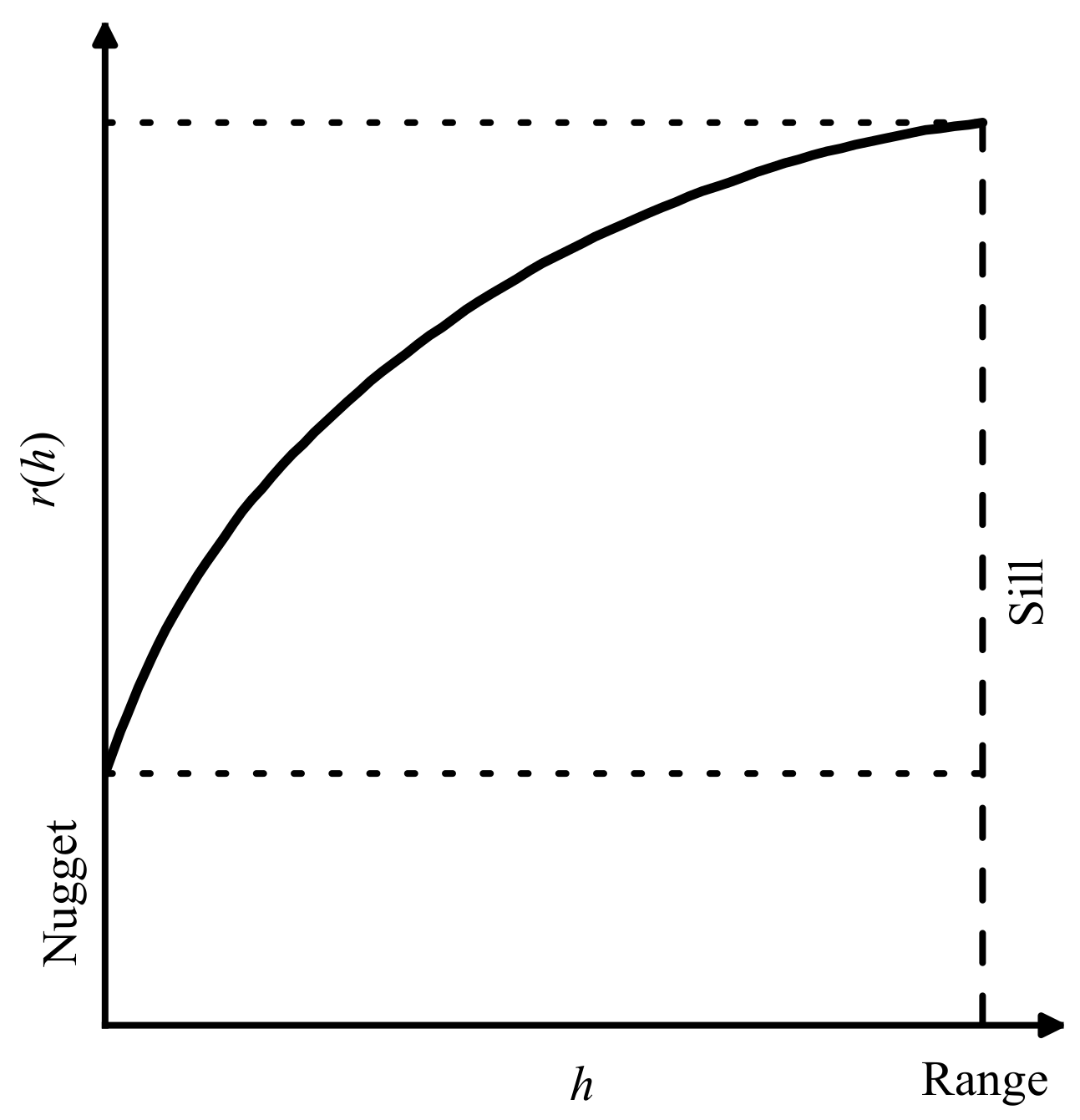
References
- Zhang, A.J.; Ye, C. Beijing Groundwater, 1st ed.; Geological Publishing House: Beijing, China, 2008; pp. 122–126. [Google Scholar]
- Zhang, Z.; Guo, H.; Zhao, W.; Liu, S.; Cao, Y.; Jia, Y. Influences of groundwater extraction on flow dynamics and arsenic levels in the western Hetao Basin, Inner Mongolia, China. Hydrogeol. J. 2018, 26, 1499–1512. [Google Scholar] [CrossRef]
- Sahoo, S.; Russo, T.A.; Elliott, J.; Foster, I. Machine learning algorithms for modeling groundwater level changes in agricultural regions of the U.S. Water Resour. Res. 2017, 53, 3878–3895. [Google Scholar] [CrossRef]
- Chen, M.; Tomás, R.; Li, Z.; Motagh, M.; Li, T.; Hu, L.; Gong, H.; Li, X.; Yu, J.; Gong, X. Imaging Land Subsidence Induced by Groundwater Extraction in Beijing (China) Using Satellite Radar Interferometry. Remote Sens. 2016, 8, 468. [Google Scholar] [CrossRef] [Green Version]
- Pellicone, G.; Caloiero, T.; Modica, G.; Guagliardi, I. Application of several spatial interpolation techniques to monthly rainfall data in the Calabria region (southern Italy). Int. J. Climatol. 2018, 38, 3651–3666. [Google Scholar] [CrossRef]
- Thiesen, S.; Vieira, D.M.; Mälicke, M.; Loritz, R.; Wellmann, J.F.; Ehret, U. Histogram via entropy reduction (HER): An information-theoretic alternative for geostatistics. Hydrol. Earth Syst. Sci. 2020, 24, 4523–4540. [Google Scholar] [CrossRef]
- Ohmer, M.; Liesch, T.; Goeppert, N.; Goldscheider, N. On the optimal selection of interpolation methods for groundwater contouring: An example of propagation of uncertainty regarding inter-aquifer exchange. Adv. Water Resour. 2017, 109, 121–132. [Google Scholar] [CrossRef]
- Adhikary, P.P.; Dash, C. Comparison of deterministic and stochastic methods to predict spatial variation of groundwater depth. Appl. Water Sci. 2017, 7, 339–348. [Google Scholar] [CrossRef] [Green Version]
- Uc Castillo, J.L.; Ramos Leal, J.A.; Martínez Cruz, D.A.; Rodríguez Robles, U.; Cervantes Martínez, A.; Marín Celestino, A.E. Identification of the Dominant Factors in Groundwater Recharge Process, Using Multivariate Statistical Approaches in a Semi-Arid Region. Sustainability 2021, 13, 11543. [Google Scholar] [CrossRef]
- Bronowicka-Mielniczuk, U.; Mielniczuk, J.; Obroślak, R.; Przystupa, W. A Comparison of Some Interpolation Techniques for Deter-mining Spatial Distribution of Nitrogen Compounds in Groundwater. Int. J. Environ. Res. 2019, 13, 679–687. [Google Scholar] [CrossRef] [Green Version]
- Fazeli Sangani, M.; Namdar Khojasteh, D.; Owens, G. Dataset characteristics influence the performance of different inter-polation methods for soil salinity spatial mapping. Environ. Monit. Assess. 2019, 191, 1–12. [Google Scholar] [CrossRef]
- Karami, S.; Madani, H.; Katibeh, H.; Marj, A. Assessment and modeling of the groundwater hydrogeochemical quality param-eters via geostatistical approaches. Appl. Water Sci. 2018, 8, 1–13. [Google Scholar] [CrossRef] [Green Version]
- Zafor, M.A.; Alam, M.J.B.; Rahman, M.A.; Amin, M.N. The analysis of groundwater table variations in Sylhet region, Bangladesh. Environ. Eng. Res. 2017, 22, 369–376. [Google Scholar] [CrossRef] [Green Version]
- Chandan, K.S.; Yashwant, B.K. Optimization of Groundwater Level Monitoring Network Using GIS-based Geostatistical Method and Multi-parameter Analysis: A Case Study in Wainganga Sub-basin, India. Chin. Geogr. Sci. 2017, 27, 201–215. [Google Scholar] [CrossRef] [Green Version]
- Hussain, M.M.; Bari, S.H.; Tarif, M.E.; Rahman, M.T.U.; Hoque, M.A. Temporal and spatial variation of groundwater level in Mymensingh district, Bangladesh. Int. J. Hydrol. Sci. Technol. 2016, 6, 188. [Google Scholar] [CrossRef]
- Zhang, H.; Wang, X.S. The impact of groundwater depth on the spatial variance of vegetation index in the Ordos Plateau, China: A semivariogram analysis. J. Hydrol. 2020, 588, 125096. [Google Scholar] [CrossRef]
- Yin, S.; Gu, X.; Xiao, Y.; Wu, W.; Pan, X.; Shao, J.; Zhang, Q. Geostatistics-based spatial variation characteristics of groundwater levels in a wastewater irrigation area, northern China. Water Sci. Technol. Water Supply 2017, 17, 1479–1489. [Google Scholar] [CrossRef]
- Wakode, H.B.; Baier, K.; Jha, R.; Azzam, R. Impact of urbanization on groundwater recharge and urban water balance for the city of Hyderabad, India. Int. Soil Water Conserv. Res. 2018, 6, 51–62. [Google Scholar] [CrossRef]
- Yue, H.; Liu, Y. Water balance and influence mechanism analysis: A case study of Hongjiannao Lake, China. Environ. Mental. Monit. Assess. 2021, 193, 1–17. [Google Scholar] [CrossRef] [PubMed]
- Mahmoudpour, M.; Khamehchiyan, M.; Nikudel, M.R.; Ghassemi, M.R. Numerical simulation and prediction of regional land subsid-ence caused by groundwater exploitation in the southwest plain of Tehran, Iran. Eng. Geol. 2016, 201, 6–28. [Google Scholar] [CrossRef]
- Dash, C.; Sarangi, A.; Singh, D.K.; Adhikary, P.P. Numerical simulation to assess potential groundwater recharge and net ground-water use in a semi-arid region. Environ. Monit. Assess. 2019, 191, 1–14. [Google Scholar] [CrossRef]
- Négrel, P.; Petelet-Giraud, E.; Widory, D. Strontium isotope geochemistry of alluvial groundwater: A tracer for ground-water resources characterisation. Hydrol. Earth Syst. Sci. 2004, 8, 959–972. [Google Scholar] [CrossRef]
- Yue, C.F.; Wang, Q.J.; Li, Y.Z. Evaluating water resources allocation in arid areas of northwest China using a projection pursuit dynamic cluster model. Water Supply 2019, 19, 762–770. [Google Scholar] [CrossRef]
- Tian, R.; Wu, J. Groundwater quality appraisal by improved set pair analysis with game theory weightage and health risk estimation of contaminants for Xuecha drinking water source in a loess area in Northwest China. Hum. Ecol. Risk Assess. Int. J. 2019, 25, 132–157. [Google Scholar] [CrossRef]
- Giao, N.T.; Nhien, H.T.H.; Anh, P.K.; Van Ni, D. Classification of water quality in low-lying area in Vietnamese Mekong delta using set pair analysis method and Vietnamese water quality index. Environ. Monit. Assess. 2021, 193, 1–16. [Google Scholar] [CrossRef] [PubMed]
- Jin, J.L.; Shen, S.X.; Li, J.Q.; Cui, Y.; Wu, C.G. Assessment and Diagnosis Analysis Method for Regional Water Resources Carrying Capac-ity Based on Connection Number. J. North China Univ. Water Resour. Electr. Power 2018, 39, 1–9. [Google Scholar] [CrossRef]
- Yang, Y.F.; Wang, H.R.; Zhao, W.J.; Yan, G.W. Evaluation Model of Water Resources Carrying Capacity Based on Set Pair Potential and Partial Connection Number. Adv. Eng. Sci. 2021, 53, 99–105. [Google Scholar] [CrossRef]
- Yang, H.M.; Zhao, K.Q. The calculation and application of partical connection numbers. CAAI Trans. Intell. Syst. 2019, 14, 865–876. [Google Scholar] [CrossRef]
- Cambardella, C.A.; Moorman, T.B.; Novak, J.M.; Parkin, T.B.; Karlen, D.L.; Turco, R.F.; Konopka, A.E. Field-Scale Variability of Soil Properties in Central Iowa Soils. Soil Sci. Soc. Am. J. 1994, 58, 1501–1511. [Google Scholar] [CrossRef]
- Gao, F.; Wang, H.X.; Liu, C.M. Variation in groundwater resources carrying capacity in Beijing between 2001 and 2015. Chin. J. Eco-Agric. 2019, 27, 1088–1096. [Google Scholar] [CrossRef]
- Yu, H.Z.; Li, L.J.; Li, J.Y. Evaluation of water resources carrying capacity in the Beijing-Tianjin-Hebei Region based on quantity-quality-water bodies-flow. Resour. Sci. 2020, 42, 02000358. [Google Scholar] [CrossRef]
- Li, Y.L.; Guo, X.N.; Guo, D.Y.; Wang, X.H. An evaluation method of water resources carrying capacity and application. Prog. Geogr. 2017, 36, 342–349. [Google Scholar] [CrossRef] [Green Version]
- Jin, J.L.; He, P.; Zhang, H.Y.; Li, J.Q.; Chen, M.L.; He, J. Subtractive full neighbor connection number and its application in trend analysis of re-gional water resources carrying capacity. J. Northwest Univ. 2020, 50, 438–446. [Google Scholar] [CrossRef]
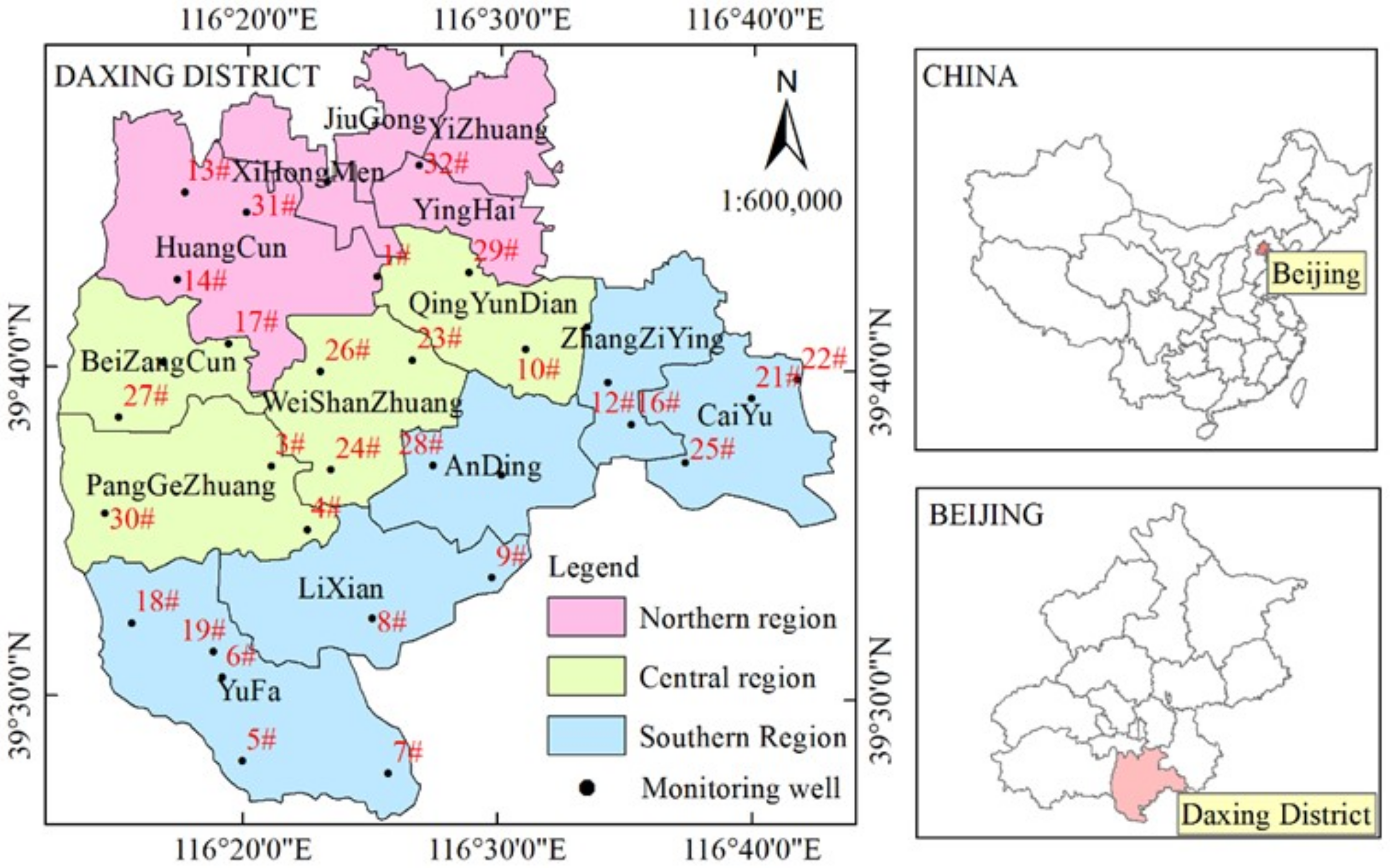
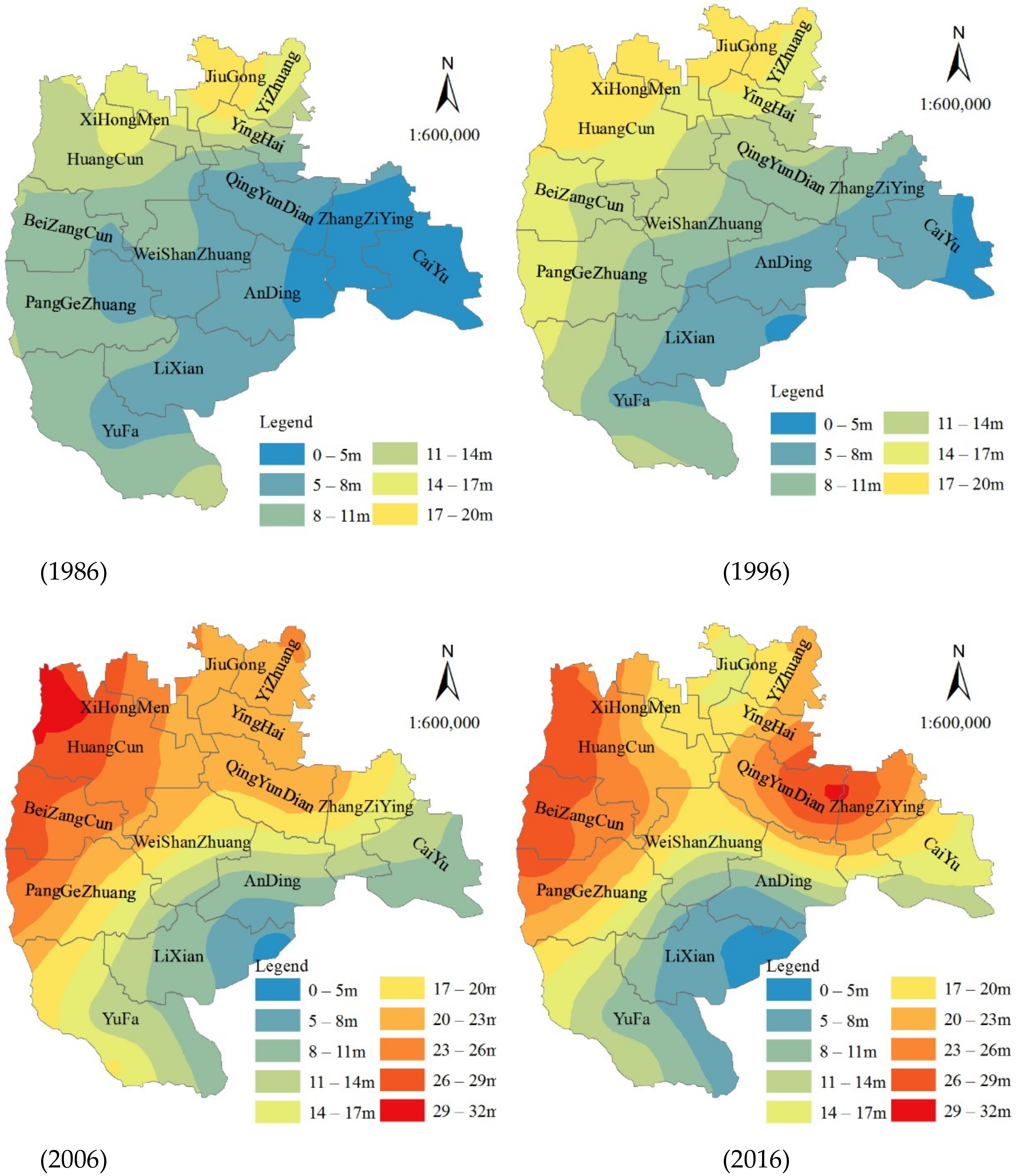
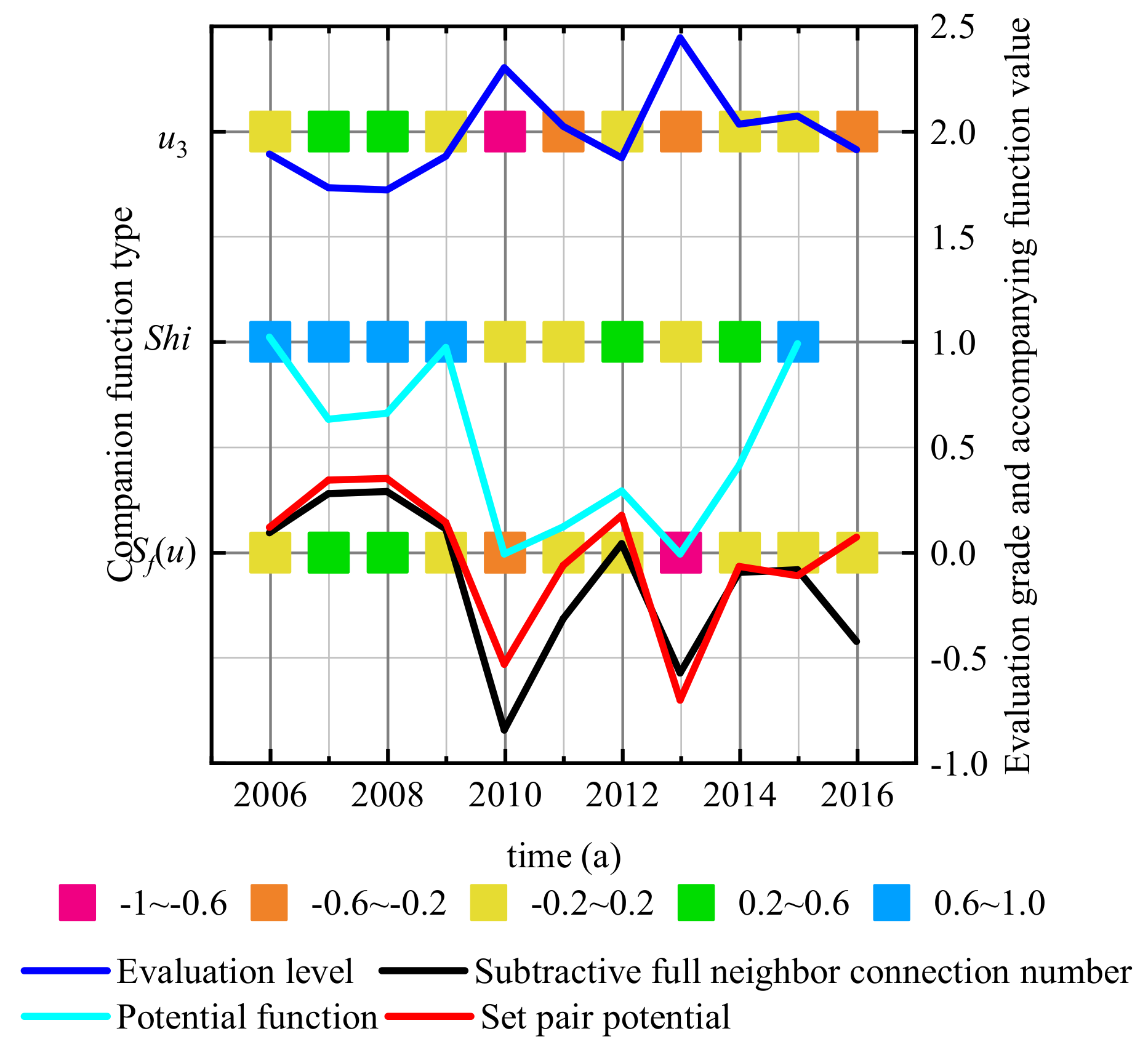
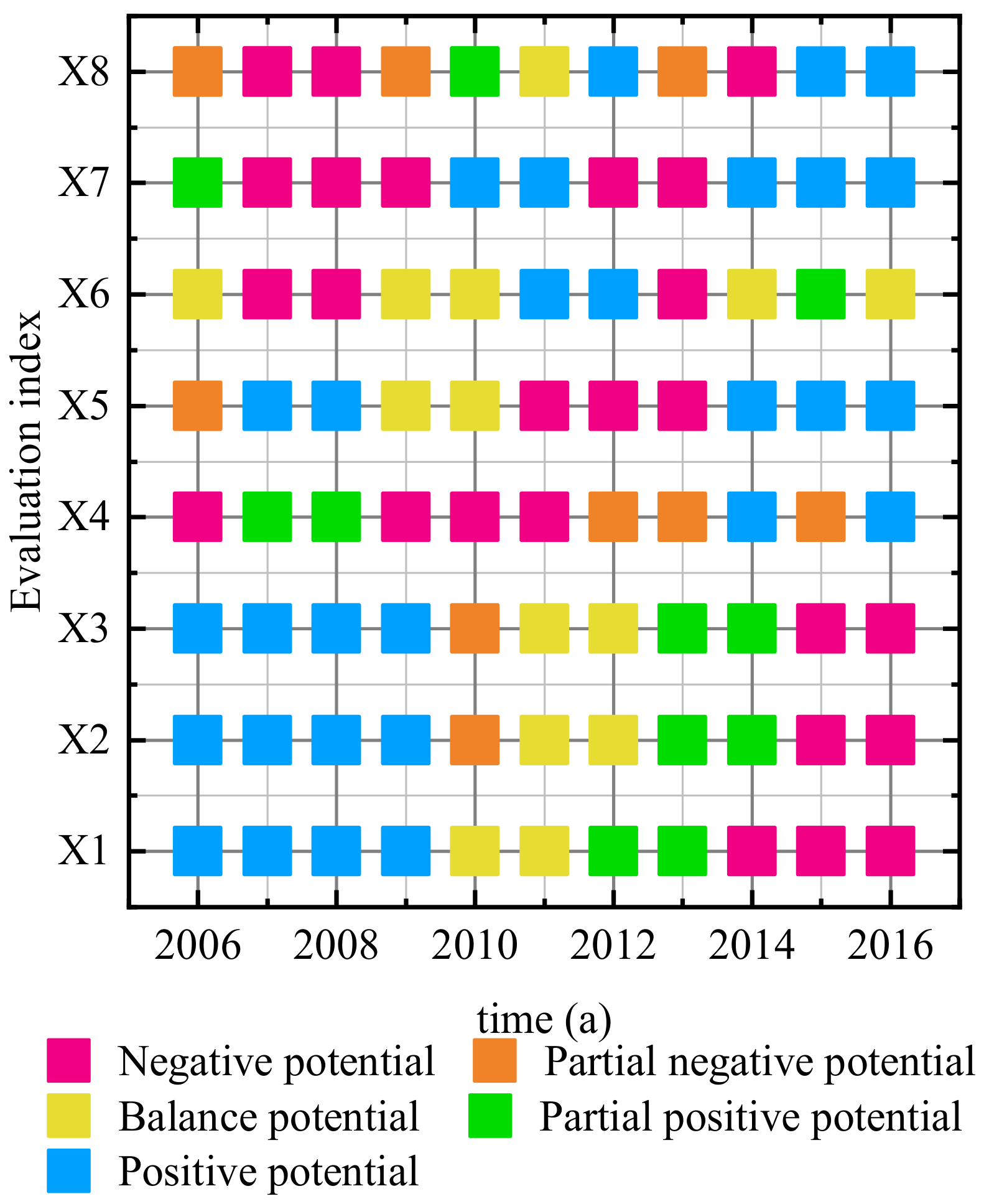
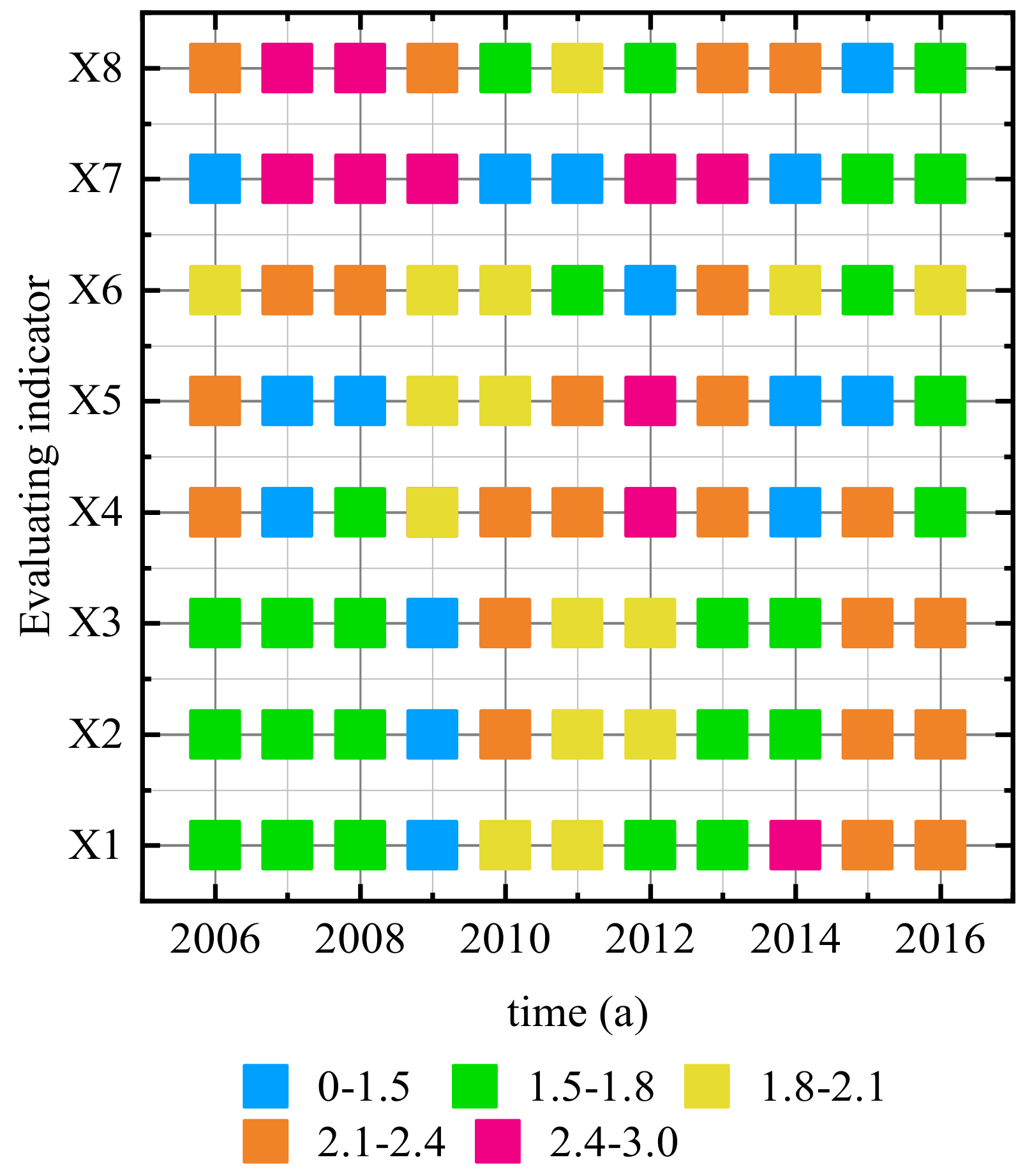
| Method | Advantages | Disadvantages |
|---|---|---|
| IDW | Wide application range and fast calculation speed | IDW can produce bullseyes around data |
| GPI | Suitable for surface with slow change in spatial data and fast calculation speed | The edge position of data has great influence on the interpolation result |
| LPI | Suitable for reflecting short-range change of spatial data and medium computing speed | Prone to strip phenomenon |
| Tspline | Suitable for surfaces with flat spatial data. Compared with GPI, this method provides accurate interpolation and has medium calculation speed | In a short range, when the data change considerably or the sampling point data have great uncertainty, the interpolation results will be greatly affected |
| OK | The interpolation accuracy is less affected by the sample density and number, and the interpolation effect is good with high accuracy | Intensive calculation and slow operation speed |
| SK | SK is the same as OK, but also the linear estimation of regionalized variables; the interpolation effect is slightly worse than OK | Intensive calculation and slow operation speed |
| UK | UK is an extension of OK, which can add explanatory variables to the model | Intensive calculation and slow operation speed |
| Interpolation Model | Data Conversion | Maximum Number of Predicted Points within the Search Radius | Minimum Number of Predicted Points within the Search Radius | Variation Function | Mean (m) | Root Mean Square (m) | Nash-Sutcliffe Efficiency Coefficient |
|---|---|---|---|---|---|---|---|
| IDW | no | 15 | 10 | / | 0.1816 | 4.5373 | 0.70 |
| GPI | no | / | / | / | 0.0787 | 5.2072 | 0.81 |
| LPI | no | 20 | 10 | / | 0.1309 | 3.9898 | 0.83 |
| Tspline | no | 25 | 10 | / | 0.1348 | 4.2010 | 0.80 |
| OK | no | 15 | 5 | Globular model | 0.0507 | 3.9577 | 0.89 |
| SK | no | 16 | 5 | Gaussian model | 0.0517 | 4.0492 | 0.86 |
| UK | no | 12 | 5 | Globular model | 0.0536 | 3.9865 | 0.88 |
| Name | 1986–1995 | 1996–2005 | 2006–2016 |
|---|---|---|---|
| Nugget value | 1.88 | 5.85 | 28.03 |
| Partial sill | 47.06 | 45.53 | 78.95 |
| Sill | 48.94 | 51.38 | 106.98 |
| Nugget effect | 0.04 | 0.10 | 0.26 |
| No. | Subsystem | Evaluation Index | Symbol | Evaluation Index | Index Weight | ||
|---|---|---|---|---|---|---|---|
| Weak (Level I) | Medium (Level II) | Strong (Level III) | |||||
| 1 | Domestic water | Population (10,000) | X1 | ≤115.90 | 115.90–150.70 | >150.70 | 0.1480 |
| 2 | Industrial water | Gross industrial production (100 million yuan) | X2 | ≤109.28 | 109.28–202.48 | >202.48 | 0.1476 |
| 3 | Tertiary industry water | GDP of the tertiary industry (100 million yuan) | X3 | ≤189.81 | 189.81–338.37 | >338.37 | 0.1586 |
| 4 | Agricultural water | Irrigation area (10,000 mu) | X4 | ≤18.42 | 18.42–19.35 | >19.35 | 0.1132 |
| 5 | Vegetable field area (10,000 mu) | X5 | ≤3.04 | 3.04–3.15 | >3.15 | 0.1141 | |
| 6 | Facility agricultural area (10,000 mu) | X6 | ≤7.87 | 7.87–7.98 | >7.98 | 0.0862 | |
| 7 | Fruit tree area (10,000 mu) | X7 | ≤6.96 | 6.96–31.33 | >31.33 | 0.0565 | |
| 8 | Number of underground wells | Number of motorized wells (10,000 eyes) | X8 | ≤1.17 | 1.17–1.23 | >1.23 | 0.1788 |
Publisher’s Note: MDPI stays neutral with regard to jurisdictional claims in published maps and institutional affiliations. |
© 2022 by the authors. Licensee MDPI, Basel, Switzerland. This article is an open access article distributed under the terms and conditions of the Creative Commons Attribution (CC BY) license (https://creativecommons.org/licenses/by/4.0/).
Share and Cite
Li, C.; Men, B.; Yin, S. Spatiotemporal Variation of Groundwater Extraction Intensity Based on Geostatistics—Set Pair Analysis in Daxing District of Beijing, China. Sustainability 2022, 14, 4341. https://doi.org/10.3390/su14074341
Li C, Men B, Yin S. Spatiotemporal Variation of Groundwater Extraction Intensity Based on Geostatistics—Set Pair Analysis in Daxing District of Beijing, China. Sustainability. 2022; 14(7):4341. https://doi.org/10.3390/su14074341
Chicago/Turabian StyleLi, Chen, Baohui Men, and Shiyang Yin. 2022. "Spatiotemporal Variation of Groundwater Extraction Intensity Based on Geostatistics—Set Pair Analysis in Daxing District of Beijing, China" Sustainability 14, no. 7: 4341. https://doi.org/10.3390/su14074341
APA StyleLi, C., Men, B., & Yin, S. (2022). Spatiotemporal Variation of Groundwater Extraction Intensity Based on Geostatistics—Set Pair Analysis in Daxing District of Beijing, China. Sustainability, 14(7), 4341. https://doi.org/10.3390/su14074341







